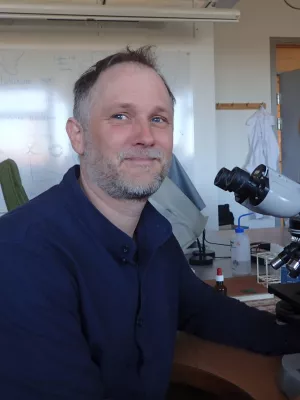
Karl Ljung
Lecturer

Quantitative landscape reconstruction and erosion history during the past 1,100 years in the Skogaryd Research Catchment, southern Sweden
Author
Summary, in English
A sediment sequence from a small forest lake in southwestern Sweden was investigated to explore the effects of forestry and land-use on catchment erosion and delivery of organic and minerogenic matter to the lake. Catchment-scale vegetation changes during the last 1,100 years were reconstructed quantitatively at 50-year resolution using pollen analysis and the Landscape reconstruction algorithm (LRA). Variations in terrestrial organic matter input to lake sediments were assessed by total organic carbon (TOC) content and carbon to nitrogen (C/N) ratios. Changes in minerogenic matter were analysed using X-ray fluorescence (XRF) scanning. The results show that Skogaryd was not intensively used for agriculture throughout the past 1,100 years, but its land-use changes were very sensitive to societal changes. Between ca. ad 950 and 1350, local land-use was characterized by small-scale agricultural activities associated with the Medieval expansion, and enhanced soil erosion was recorded by increased K, Ti and Rb deposition. Around ad 1350 much of the farmland was abandoned, most likely in response to outbreaks of plague. The abandonment of farmland caused increased coniferous woodland cover and lower soil erosion. From the 16th century land-use expanded and gradually intensified, concurrent with a population increase documented in the study area between ca. ad 1600 and 1850. Intensive exploitation of the forest led to soil erosion and increased terrestrial organic and minerogenic matter export to the lake. These processes peaked with the artificial drainage of a nearby wetland for agricultural purposes. During the 20th century, modern forestry management started with the plantation of conifers, and soil erosion declined.
Department/s
- Quaternary Sciences
- MERGE: ModElling the Regional and Global Earth system
- Department of Geology
- Environmental Science
Publishing year
2020-01-30
Language
English
Publication/Series
Vegetation History and Archaeobotany
Document type
Journal article
Publisher
Springer
Topic
- Geosciences, Multidisciplinary
Status
Published
Project
- A centennial- to millennial-scale perspective on the Skogaryd Research Catchment based on lake sediments.
- Late Holocene climate change and human impacts in southern Sweden based on lake sediments
- Implications of land use on the carbon cycle - Impacts of long-term human activities on terrestrial organic matter input to aquatic ecosystems in southern Sweden
ISBN/ISSN/Other
- ISSN: 1617-6278

